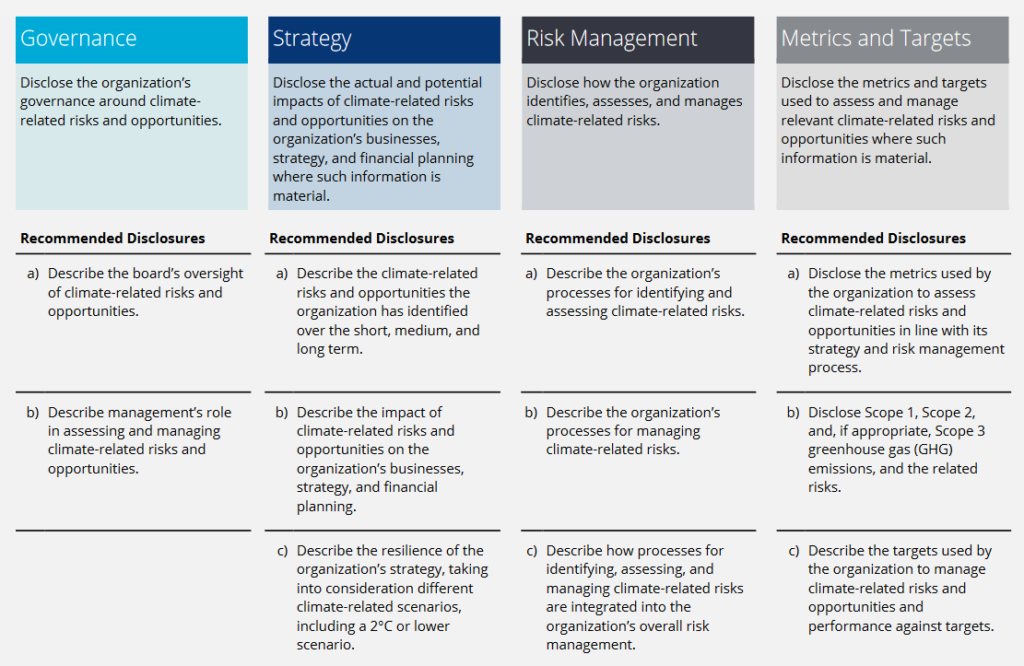One of the US’s largest commercial banks has published its first-ever climate risk report – revealing the three of its portfolios most at risk from climate change.
Truist, formed in 2019 by the merger of SunTrust and BB&T, has assets of $509 billion.
“Climate change poses physical risks—from the direct impacts of changing climate patterns and extreme weather events like damage to assets and service disruptions, and transition risks— from disruptions and changes in regulations, technologies, and market dynamics as we move towards a lower carbon economy,” Truist said.
Follow ESG Insight on LinkedIn
Its inaugural Task Force on Climate-Related Financial Disclosures (TCFD) Report is its third ESG-related report this year, following a June CSR and ESG report and a February ESG Bond Framework. (All were reported in PDF format as standalone reports. ESG Insight has asked the bank if it plans to publish XBRL/machine-readable versions.)
The 2021 Truist TCFD report compiles the climate risks faced by the bank into a “comprehensive risk inventory… classified into eight primary risk types — strategic, credit, market, liquidity, compliance, operational, technology, and reputational risk.”
It will not be able to report on “financed emissions” from its loans and investments until 2024, the Truist climate risk report noted meanwhile – a disappointing admission two decades after Trucost first analysed the emissions of an investment portfolio. (It will report these in line with 2020 Partnership for Carbon Accounting Financials “PCAF” guidance for calculating financed emissions for six asset classes.)
Truist climate risk report: Vulnerable portfolios
The Truist climate risk report highlighted its residential mortgages, commercial real estate (CRE) and commercial and industrial (C&I) portfolios as most vulnerable.
Flooding and hurricane risk is the biggest threat to residential mortgages it found. Approximately 24% of Truist’s residential portfolio is exposed to hurricane risk, while 14% of the residential mortgage portfolio is exposed to flooding risk, the report found.
The firm’s already recognised losses as a result from this exposure: between 2015 and 2020, Truist suffered over $10 million in net losses from physical damage due to acute events like Hurricanes Irma and Florence. (The Truist climate risk report notes that the bank has “evaluated various impacts that could result from climate change including a hypothesized demographic shift away from areas subject to chronic physical risks.”)
About 12% of Truist’s C&I portfolio meanwhile faces high “transition risks, concentrated in Oil and Gas, Auto, and Electric Power Generation, Transmission, and Distribution. Approximately 41% of its C&I portfolio faces moderate transition risk.
What is TCFD reporting?

The TCFD was created in 2015 by multilateral organisation the Financial Stability Board (FSB) to develop “consistent climate-related financial risk disclosures for use by companies, banks, and investors in providing information to stakeholders.”
There are four pillars of TCFD disclosures – Governance, Strategy, Risk Management, and Metrics and Targets with 11 recommended disclosures, illustrated above.
The FSB argues that governance processes for climate-related disclosures should be “as rigorous as those used for existing public financial disclosures, including review by the chief financial officer, audit committee, and Board of Directors, as appropriate.”
Truist’s ESG actions and challenges
Truist in March 2021 issued its first social bond of $1.25 billion as part of the company’s ESG strategy. This will support social programs, including investments in affordable housing and enhancements to non-profit services for communities in need. The first social bond issued by a regional US bank, the 1.267% fixed-to-floating rate senior notes (due March 2, 2027) were oversubscribed by 2.7 times: “Investing in our communities is one of the most tangible ways we’re able to fulfill our purpose of inspiring and building better lives and communities,” said Tori Kaplan, Truist’s CSR lead.
Its 2021 CSR and ESG report saw it vow to reduce Scope 1 and Scope 2 emissions by 35% each and to reduce its water consumption by 25% by 2030; relative to a 2019 baseline.
Critically, the Truist climate risk report emphasises the extent to which the bank is now integrating a new climate risk management function into its existing ESG and risk management functions “to help ensure that the management and governance of climate risk is incorporated into enterprise-wide risk management practices.”
The bank in 2021 expanded its ESG reporting with more disclosures under SASB and GRI, disclosed its alignment with the United Nations’ Sustainable Development Goals (SDGs), and completed its first public CDP survey in July of 2021.
When it comes to financed emissions, Truist said it had undertaken a preliminary assessment of the financed emissions for the three of its portfolios most exposed to climate change as detailed above, using PCAF’s 2020 methodology.
“This preliminary assessment helped us identify the data needed for such calculations, the importance of data quality on the accuracy of the calculations, and the benefits of integrating the needed data and calculations directly into key systems so we can leverage existing internal processes. As we continue working to merge our heritage banks’ data collection systems and improve our processes to gather more comprehensive, higher quality data, we will be better positioned to disclose our financed emissions in the future.
“Given our increased understanding of methodologies to calculate financed emissions, Truist is proud to join PCAF and commit to publishing the financed emissions from our loans and investments within three years” it concluded in the Truist TCFD report.
See also: Goldman Sachs Will Add Carbon Accounting Of Client Portfolios To Its Investing Application









